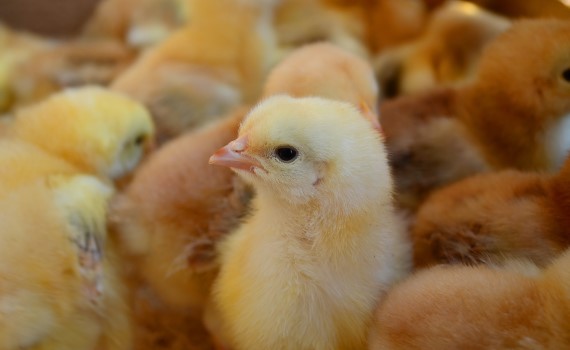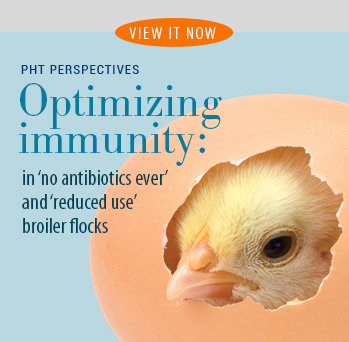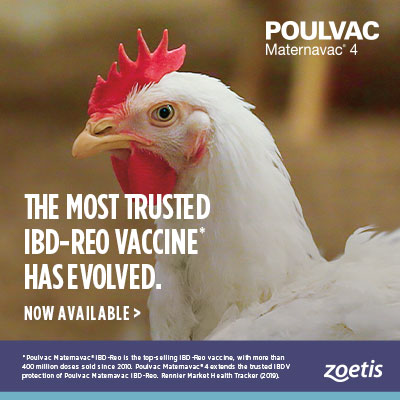Veterinarian offers strategies for managing viral diseases in recombinant-based vaccination programs
A well-designed vaccination program including recombinant vaccines can help protect flocks against Marek’s disease, infectious bursal disease (IBD) and some viral respiratory diseases while providing more flexibility for managing other common diseases such as infectious bronchitis (IB), according to Kalen Cookson, DVM, director of clinical research, Zoetis.
With its immunosuppressive properties, IBD virus poses one of the biggest disease risks to young birds, especially if infection occurs within the first 2 weeks of life, Cookson said during a recent Zoetis forum.
“If the IBDV challenge window is during the first 2 weeks, I can guarantee your flocks are suffering from immune suppression and are not performing up to their standard,” Cookson said. “There’s a lot of money being left on the table.”
If the IBDV challenge occurs between 2 and 3 weeks of age, immune suppression may not be as profound but can allow other diseases to impact the immune system. Birds challenged at ages older than 3 weeks can have moderate to temporary suppression that coincides with challenges from IB and adenoviruses, Cookson said.
Breeder, broiler vaccines close immunity gap
Protection against IBDV requires both strong breeder and broiler vaccination programs to successfully protect against IBDV challenges throughout a broiler’s life.1
“When a breeder program contains more antigenic diversity — for example, with Poulvac Maternavac® in their program — it helps boost maternally derived immunity in their offspring, often beyond 3 weeks of age,” Cookson explained. “This helps reduce the potential of having permanent immune suppression.”2,3
The breeder program should be followed by a broiler plan that covers the gap between the loss of maternal immunity and the onset of active immunity. Not covering the gap could mean the difference between IBD-related immune suppression or flocks with intact immune systems.
“If that gap is wide enough, say a 7-day gap where you don’t have sufficient immunity, that is all the IBDV challenge needs to make its way through a flock,” Cookson said.
A broiler recombinant vaccine program such as Poulvac® Procerta® HVT-IBD provides active immunity to help cover the gap against a high field challenge.4
“Flocks may still get infected with a field virus, but they will be better cushioned against its full effects,” he said. “The influence of that infection will not have a significant impact on their immune system.”
How to choose vaccines
Recombinant and live vaccines offer protection against IBDV and offer different benefits. Live vaccines, which can be applied in the hatchery with or without recombinant vaccines, provide partial protection within a few days that peaks between 2 to 3 weeks of age and then quickly starts to wane. Maternal antibodies can interfere with them too.
Recombinants, meanwhile, provide partial protection in 10 to 12 days. Immunity peaks between 3 to 4 weeks of age and stays high for the rest of a broiler’s life, Cookson said.
“Recombinants do not always prevent field infections but do provide a nice cushion of protection from the damage of infection, whether it’s a Newcastle infection with less tracheal damage or an IBD situation with less bursal atrophy,” he added.
“Meanwhile, live vaccines with sufficient activity levels may reduce field infection and future field challenge,” he continued. “If used strategically, live vaccines can help recombinants be more successful over the long haul by taking some of the field pressure off them.”
Seasonal considerations
Conditions for field challenges build up during winter months as ventilation rates decrease, resulting in increased viral, bacterial, ammonia and dust levels.
“You have increased viral loads so IBDV, bronchitis viruses, Newcastle viruses and others that can tax the immune and respiratory systems all tend to increase over time through winter,” Cookson explained. Secondary infections also increase.
The best strategies he suggested to survive winter are using mild, live vaccines and/or recombinant vaccines for IBDV and ND. By applying the ND component through a recombinant, the live-vaccine program can focus on just IB vaccines to handle bronchitis issues.
Field challenges naturally diminish with higher ventilation rates in spring, summer and early fall. Cookson suggested taking advantage of these conditions to further reduce field-virus pressure.
“Conventional live B1-type vaccines are more easily tolerated by flocks and can be much more effective in reducing hot pockets of Newcastle challenge, which may have built up over the winter,” he said. “We can also use live immune complex or field IBD vaccines to further reduce the IBD challenge.
“The goal is ultimately preparing for that next winter season so we can better survive it. By reducing our IBDV and Newcastle ‘noise,’ our recombinants can be even more effective, and our customers can focus on better overall health and performance.”
ND vaccine strategies
During the winter, Cookson said, recombinant ND vaccines help minimize ‘noise’ — a colloquial term that refers to both flock performance variability due to disease or vaccine reactions, as well as the audible snicking and sneezing that accompany respiratory disease. Because recombinant vaccines do not cause reactions or compete with IB vaccines for replication, producers can completely and exclusively focus their live respiratory program on bronchitis.
In addition, recombinant ND vaccines provide life-long protection in broilers. Cookson said that in studies, the recombinant HVT-IBD-ND vaccine provided 90% protection by 3 weeks of age5 and 100% protection out to 63 days of age.6
Mild, live vaccines for ND still may cause a mild reaction and will compete with live bronchitis vaccines used during this same time, he added. Protection will be good by 2 to 3 weeks of age but duration of immunity is relatively short compared to recombinants.7
In the summer, very little recombinant ND vaccine is used because live vaccines control the disease well and noise is not an issue. But setting up for winter, Cookson suggested using the more efficacious, conventional B1-type vaccines to reduce field pressure from ND challenges — even if they only exist in occasional pockets.
In contrast, mild ND vaccines have minimal impact on reducing field pressure and quelling hotspot challenges, he added.
Recombinant versus live IBD vaccines
Winter is the best time to use recombinant IBD vaccines in most situations, according to Cookson. However, a live vaccine may provide complementary protection by helping to block the effects of a high, early challenge for boilers at 2 to 3 weeks of age.
In summer, producers can choose to continue recombinant vaccines, but field virus keeps replicating and this may encourage a field challenge to adapt to this immune pressure.
If flocks are taken off recombinants, immune pressure eases, but field replication can increase. Again, recombinants don’t prevent infections but do minimize or reduce the amount of infection that occurs compared to no vaccination.
Another option is adding a live, immune complex vaccine such as Poulvac® Bursaplex® or conventional live vaccines Bursine®-2 or Bursine® Plus to the vaccine program to further reduce the impact of field challenges and better prepare for the next winter season.
In conclusion, Cookson said recombinant vaccines can help producers reduce noise and disease caused by IBDV and NDV, leading to less potential immune suppression and respiratory disease during the most challenging time of year.
1 Jackwood D. Monitoring field strains key to successful vaccination against IBDV. Poultryproducer.com https://www.poultryproducer.com/commentaries/monitoring-field-strains-key-to-successful-vaccination-against-ibdv-by-daral-j-jackwood-phd-professor-the-ohio-state-university/ Accessed January 13, 2022.
2 Ibid.
3 Dey S, et al. Infectious bursal disease virus in chickens: prevalence, impact, and management strategies. Vet Med (Auckl). 2019; 10: 85–97.
4 Gelb J, et al. Efficacy of Recombinant HVT-IBD Vaccines Administered to Broiler Chicks from a Single Breeder Flock at 30 and 60 Weeks of Age. Avian Dis. 2016 Sep;60(3):603-12.
5 Data on file, Study Report No. B812W-US-18-A07, Zoetis LLC.
6 Data on file, Study Report No. B814R-US-19-C18, Zoetis LLC.
7 Dimitrov KM, Afonso CL, Yu Q, Miller PJ. Newcastle disease vaccines—A solved problem or a continuous challenge? Veterinary Microbiology. 2017;206:126-136. doi:10.1016/j.vetmic.2016.12.019.
All trademarks are the property of Zoetis Services LLC or a related company or a licensor unless otherwise noted.
©2022 Zoetis Services LLC. All rights reserved. BIO-00347
Posted on July 8, 2022

















